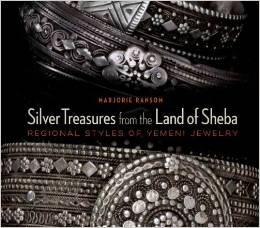By Alyssa Wood
Silver Treasures from the Land of Sheba: Regional Yemeni Jewelry
By Marjorie Ransom
The American University in Cairo Press, 2014
With more than 300 color plates, this lavishly illustrated tome offers a wonderful introduction to Yemeni crafts, touching on embroidery as well as the silversmithing referred to in the title. Marjorie Ransom includes stunning examples (all expertly shot by Robert K. Liu) of a variety of hairpieces, headdresses, necklaces (lazem), earrings, bracelets, belts, swords (jambiya), anklets, and amulets. Luckily for readers, she proves an enthusiastic guide with a very readable and engaging style.
This, Ransom’s first book, grew out of her lectures and her captions from the exhibition, “Silver Speaks:Traditional Jewelry of the Middle East, “which she organized with Ellen Benson of D.C.’s Bead Museum. That exhibit featured her collection of nearly 2,000 pieces of Middle Eastern jewelry. She began collecting silver jewelry from local craftspeoplein 1966 and 1975, during the time she and her husband, David, worked as American State Department employees posted toYemen. When she realized how rapidly the pieces had begun disappearing as Yemeni women sold their silver jewelry in a quest for the more popular gold, she began to document this collection More recently, she returned to Yemen to painstakingly interview people in order to document the techniques, provenance, and cultural context of the pieces in her collection.
“Silver Treasures,” provides an overview of the traditional silversmithing of the varying regions of Yemen and their Bedouin populations (since most owners of the silver jewelry were Bedouin) with a focus on the 20th century. Where possible, she places the pieces within a specific cultural context, detailing how and under what circumstances the jewelry would be worn. Notably, in her section on Hadramaut, where women excelled in the production of loop-in-loop silver chain, she lists each item that a bride in the Sayyun region would wear for her wedding and its significance. She continues, discussing the importance of dance in the weddings and the regional preference for musical anklets and belts.
One might wish for the inclusion of first-person narratives or excerpts of her interviews, perhaps even as an appendix, given the considerable time and effort dedicated to obtaining those interviews. Hearing craftsmen and owners discuss the jewelry and its significance in their own words would add depth and richness to the text, particularly for anthropologists. In her conclusion, Ransom mentions that she plans to write a book detailing precisely the processes involved in Middle Eastern silversmithing and the people who craft it. Hopefully, this will include first person accounts. Nonetheless, it will constitute a valuable contribution to the study of Yemeni crafts.
This article appeared in Al Jadid Magazine, Vol. 19, No. 68, 2015.
Copyright © 2015 AL JADID MAGAZINE

